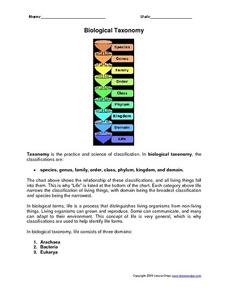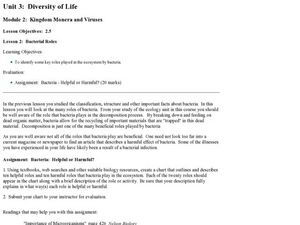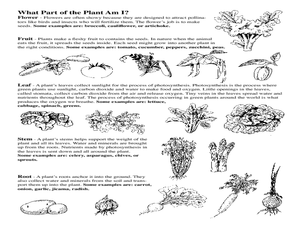Cornell University
Classification
Explore the scientific method of classification. An interactive activity asks learners to create a classification system for a group of objects and develop a flow chart to communicate their systems. In addition, individuals use a...
Curated OER
Introductory Bacteria and Virus Worksheet
Compare and contrast eukaryotes, prokaryotes, and viruses with a chart and a Venn diagram. Beginning microbiologists consider motility, reproductive ability, DNA content, and the presence of organelles. They write short answers to...
Curated OER
Campbell's Biology
Six chapters of a biology characteteristics of different domains xt are covered in this twenty-page assignment. Biology buffs chart the characteristics of different groups of organisms and address many critical-thinking questions about...
Curated OER
Biological Taxonomy
In this biology worksheet, students read about biological taxonomy. They then use the information they learned to answer the 13 questions on the worksheet. The answers are on the last page of the packet.
Curated OER
Creating a Classification System
Students create classification system for Arctic-dwelling animals, the Arctic hare in particular.
Curated OER
Animal Classifications
Third graders work in small groups to investigate how to sort a variety of items into groups and subgroups. They work on a class chart based on the activity which show how the items are classified based on commonalities. Upon completion...
Curated OER
The Three Kingdoms of Ancient Egypt
In this World History worksheet, 6th graders identify that ancient Egypt is divided into four sections. They complete a chart where each of the four sections is broken down into specific time periods. Students write the historical...
Curated OER
Invertebrate Phyla
Students explore the invertebrate phyla. They discuss the characteristics of the invertebrate Phyla in the Kingdom Animal. Students classify organisms into Phyla based on their characteristics. They distinguish radial symmetry, bilateral...
Curated OER
Classifying Organisms within Kingdoms
Learners examine animal kingdom classifications. They discuss how animals are placed into kingdom classifications and compare similarities and differences of animals within a kingdom.
Curated OER
The Empires of Africa
Young scholars, in groups, compare and chart the different African kingdoms and city-states. They write a short essay detailing the aspects of African history that most fascinates them.
Curated OER
The Six Kingdoms
In this classification worksheet, young scholars complete a chart listing the characteristics of each of six kingdoms. They write definitions for three terms.
Curated OER
Animal Kingdom: Phylum Chordata
Students use a dichotomous key to classify various vertebrate jar speciments into classes. They examine the speciments for general characteristics of each class and fill in a corresponding chart and then complete a few final assessment...
Curated OER
Bacterial Roles
Students study bacteria and the role it plays in the ecosystem. In this bacteria lesson students research the roles bacteria has and submit a chart.
Curated OER
Halloween: Arachnids
High schoolers participate in class discussion about the movie Arachnophobia. In this biology lesson, students find articles and photos of a species that interest them. They share it with their group.
Curated OER
Plant Party
Pupils identify plant parts. In this plants lesson, students bring in a vegetable. Each student classifies which part of the plant their vegetable comes from (flower, root, ect.) Pupils identify the parts of their vegetable and later...
















